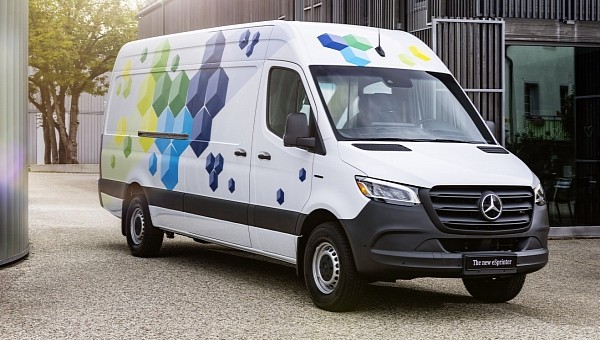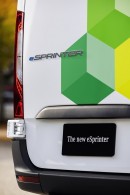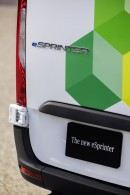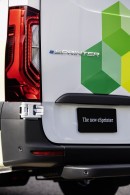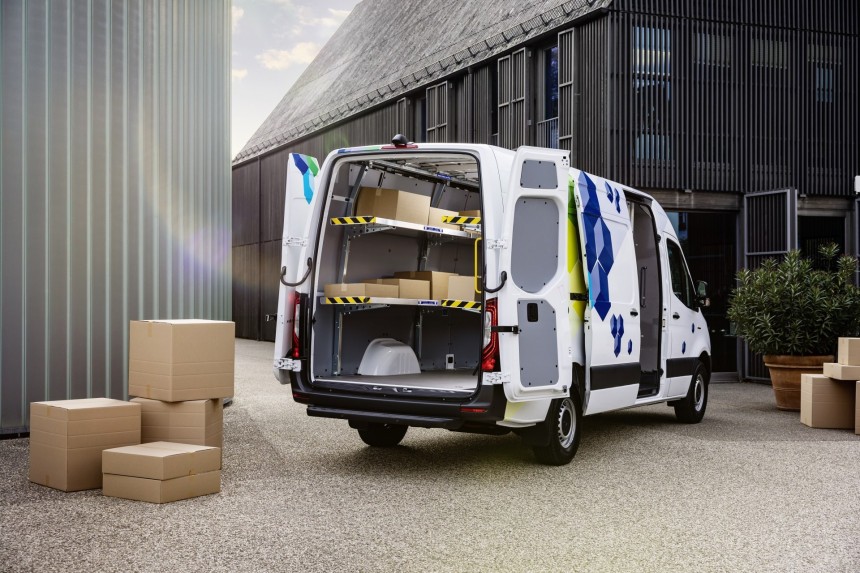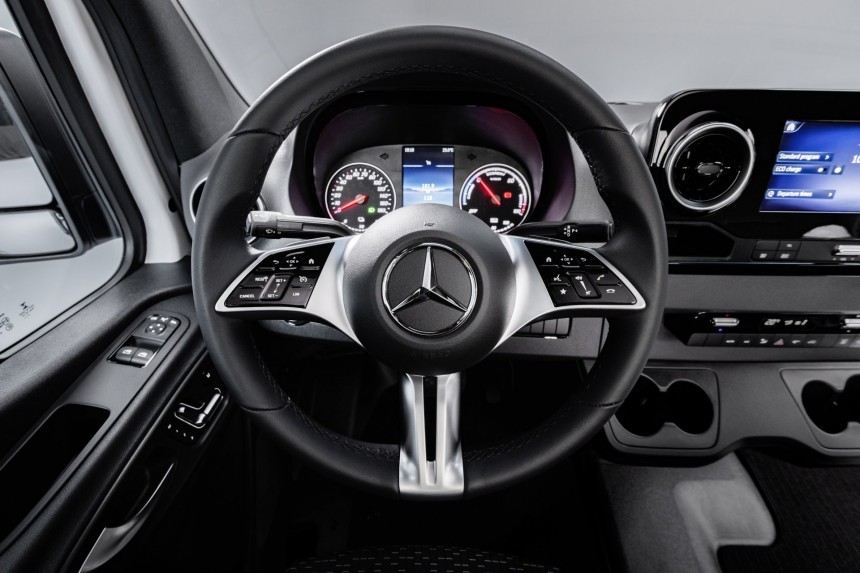Mercedes-Benz has unveiled the 2024 eSprinter, which is an electric van meant for cargo. It comes with a 113-kWh battery pack, and it will reach North America in the second half of this year. It will be made both in Germany and in the U.S.
The 2024 Mercedes-Benz eSprinter is the second generation of the electric van, and it comes with a single motor that is placed on the rear axle. It can be had in two power versions, with the base starting out at 134 horsepower (100 kW or 136 metric horsepower), while a more powerful model comes with 201 horsepower (150 kW).
Peak torque sits at 400 Nm (295 lb-ft), which is enough twist for a van in most situations, and it will feel like a conventional one with more torque since it is available from the start as such. Mercedes-Benz prides itself on a new electric rear axle, as well as a newly-developed electric motor that only weighs around 286 lb (ca. 130 kg).
The battery is a Lithium-Iron Phosphate unit that does not require cobalt or nickel, while also having active thermal management. That is great news for those interested in more sustainable batteries, and these should be cheaper to manufacture without the two rare earth metals mentioned.
Charging the battery can be done with up to 115 kW if it is connected to a suitable fast charger, and doing so will only take just over 40 minutes to increase the state of charge from 10 to 80 percent. If a standard wall plug is used, the vehicle has a 9.6 kW wall charger that will require several hours for a full charge from a nearly flat battery.
American customers, as well as those from Canada, will only get the 2024 Mercedes-Benz eSprinter in the long cargo van form with a high roof and the largest battery available in the range. The latter has a usable capacity of 113 kilowatt-hours, which is usually referred to as kWh, and it is a sizeable battery, if you ask us.
The biggest model in the eSprinter range has a maximum permissible gross vehicle weight of 4.25 tons (ca. 9,369 lb), and its load capacity is 488 cubic feet (about half the volume of a large U-Haul truck or 13.8 cubic meters).
In other words, we are writing about a lot of room, which is enough for many packages or for a one-bedroom apartment being moved without breaking a sweat. Well, the last bit depends on how much stuff you have.
The manufacturer has already presented its range estimate for the 2024 Mercedes eSprinter, and it should be able to drive for up to 400 kilometers (ca. 248 miles) in the mixed WLTP cycle.
Please take note that the units have been converted for ease of understanding, but the mileage estimates on the U.S. market will be different from the converted values obtained in the WLTP estimated cycle, as the tests that are deployed are different in the EU versus the U.S. and Canada.
If the eSprinter is only doing city driving, as it would be ideal for the last-mile scenario that is currently best for electric vans, it could drive up to 500 kilometers (ca. 311 miles) in the WLTP city cycle. Just like with a conventional van, the mileage may vary depending on weather, driving style, and several other factors.
The interior features the MBUX infotainment unit that is usually found in Mercedes-Benz cars, and it has an integrated range estimation app that connects to the navigation and real-time use.
The idea is that the collaboration will enable the driver to reach the set destination with the desired remaining charge by providing charging suggestions on the route, for example.
Mercedes-Benz will sell its latest electric van in almost 60 countries, while production is handled in Düsseldorf and Ludwigsfelde (Germany), as well as in Charleston, South Carolina. Pricing information will be announced later.
Peak torque sits at 400 Nm (295 lb-ft), which is enough twist for a van in most situations, and it will feel like a conventional one with more torque since it is available from the start as such. Mercedes-Benz prides itself on a new electric rear axle, as well as a newly-developed electric motor that only weighs around 286 lb (ca. 130 kg).
The battery is a Lithium-Iron Phosphate unit that does not require cobalt or nickel, while also having active thermal management. That is great news for those interested in more sustainable batteries, and these should be cheaper to manufacture without the two rare earth metals mentioned.
Charging the battery can be done with up to 115 kW if it is connected to a suitable fast charger, and doing so will only take just over 40 minutes to increase the state of charge from 10 to 80 percent. If a standard wall plug is used, the vehicle has a 9.6 kW wall charger that will require several hours for a full charge from a nearly flat battery.
The biggest model in the eSprinter range has a maximum permissible gross vehicle weight of 4.25 tons (ca. 9,369 lb), and its load capacity is 488 cubic feet (about half the volume of a large U-Haul truck or 13.8 cubic meters).
In other words, we are writing about a lot of room, which is enough for many packages or for a one-bedroom apartment being moved without breaking a sweat. Well, the last bit depends on how much stuff you have.
The manufacturer has already presented its range estimate for the 2024 Mercedes eSprinter, and it should be able to drive for up to 400 kilometers (ca. 248 miles) in the mixed WLTP cycle.
If the eSprinter is only doing city driving, as it would be ideal for the last-mile scenario that is currently best for electric vans, it could drive up to 500 kilometers (ca. 311 miles) in the WLTP city cycle. Just like with a conventional van, the mileage may vary depending on weather, driving style, and several other factors.
The interior features the MBUX infotainment unit that is usually found in Mercedes-Benz cars, and it has an integrated range estimation app that connects to the navigation and real-time use.
The idea is that the collaboration will enable the driver to reach the set destination with the desired remaining charge by providing charging suggestions on the route, for example.
Mercedes-Benz will sell its latest electric van in almost 60 countries, while production is handled in Düsseldorf and Ludwigsfelde (Germany), as well as in Charleston, South Carolina. Pricing information will be announced later.
